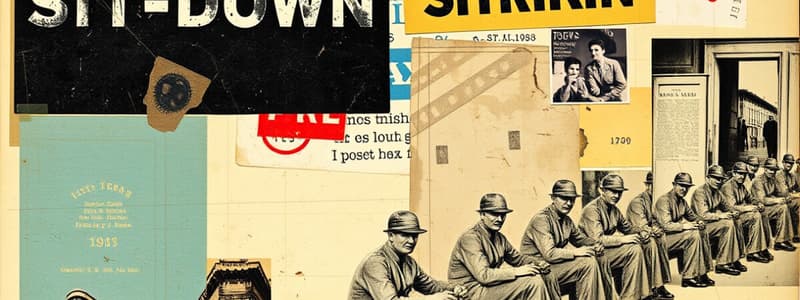Podcast
Questions and Answers
Who did Neil Leighton meet at the conference?
Who did Neil Leighton meet at the conference?
- Professor Jonathon Walker
- Professor Laurence Goodwyn (correct)
- Professor Maria Chen
- Professor Thomas Adler
What can be inferred about the conditions at the General Motors factory in Flint?
What can be inferred about the conditions at the General Motors factory in Flint?
- Men often reported high job satisfaction.
- The work was physically demanding and stressful. (correct)
- The work environment was relaxed and informal.
- The factory was known for its worker-friendly policies.
What was one of the outcomes of the strike that was settled on February 11, 1937?
What was one of the outcomes of the strike that was settled on February 11, 1937?
- General Motors agreed to a pay raise for all workers
- All plants were immediately unionized
- The UAW won all their demands completely
- Recognition of the union in the work plants (correct)
Which union was primarily involved in the organization of workers at the Flint auto plants?
Which union was primarily involved in the organization of workers at the Flint auto plants?
What contributed to the organization of unions in the Flint auto plants during the Depression era?
What contributed to the organization of unions in the Flint auto plants during the Depression era?
What strategy was undertaken by some workers after leaving the plants on December 30?
What strategy was undertaken by some workers after leaving the plants on December 30?
What exclusive right did the union gain from General Motors after the strike?
What exclusive right did the union gain from General Motors after the strike?
Which sentiment did Neil Leighton likely share with other academics at the conference regarding labor conditions?
Which sentiment did Neil Leighton likely share with other academics at the conference regarding labor conditions?
Flashcards are hidden until you start studying
Study Notes
Overview of the Flint Sit-Down Strike
- The Flint Sit-Down Strike took place in December 1936 and lasted until February 1937, involving workers at General Motors (GM) plants in Flint, Michigan.
- This significant labor action was organized by the United Auto Workers (UAW) and aimed to challenge poor working conditions and labor practices within the auto industry.
Conditions Leading to the Strike
- Work conditions in Flint's GM plants during the 1930s were characterized by long hours, low wages, and unsafe environments.
- The Great Depression intensified economic struggles, making jobs at GM highly sought after, despite the adverse conditions workers faced.
The Strike Begins
- On December 30, 1936, many workers left their shifts at the Fisher 1 and Fisher 2 plants, forming picket lines and engaging in protest activities.
- The decision for a sit-down strike was meant to prevent replacement workers from taking over their roles.
Key Events During the Strike
- The strike was marked by heightened tension between workers and law enforcement, including attempts by authorities to evict strikers.
- Sit-down tactics allowed strikers to effectively halt production without violence, strengthening their negotiating power.
Resolution of the Strike
- The strike concluded on February 11, 1937, with an agreement that recognized the UAW and allowed exclusive organization rights for six months.
- Although not all demands were met, workers gained significant victories, including improvements in labor practices and workplace safety.
Impact and Aftermath
- The Flint Sit-Down Strike was pivotal in promoting labor rights and establishing the UAW as a major force in the auto industry.
- It contributed to the growth of organized labor movements and set precedents for future strikes and negotiations across various industries.
Overview of the Flint Sit-Down Strike
- The Flint Sit-Down Strike took place in December 1936 and lasted until February 1937, involving workers at General Motors (GM) plants in Flint, Michigan.
- This significant labor action was organized by the United Auto Workers (UAW) and aimed to challenge poor working conditions and labor practices within the auto industry.
Conditions Leading to the Strike
- Work conditions in Flint's GM plants during the 1930s were characterized by long hours, low wages, and unsafe environments.
- The Great Depression intensified economic struggles, making jobs at GM highly sought after, despite the adverse conditions workers faced.
The Strike Begins
- On December 30, 1936, many workers left their shifts at the Fisher 1 and Fisher 2 plants, forming picket lines and engaging in protest activities.
- The decision for a sit-down strike was meant to prevent replacement workers from taking over their roles.
Key Events During the Strike
- The strike was marked by heightened tension between workers and law enforcement, including attempts by authorities to evict strikers.
- Sit-down tactics allowed strikers to effectively halt production without violence, strengthening their negotiating power.
Resolution of the Strike
- The strike concluded on February 11, 1937, with an agreement that recognized the UAW and allowed exclusive organization rights for six months.
- Although not all demands were met, workers gained significant victories, including improvements in labor practices and workplace safety.
Impact and Aftermath
- The Flint Sit-Down Strike was pivotal in promoting labor rights and establishing the UAW as a major force in the auto industry.
- It contributed to the growth of organized labor movements and set precedents for future strikes and negotiations across various industries.
Studying That Suits You
Use AI to generate personalized quizzes and flashcards to suit your learning preferences.




